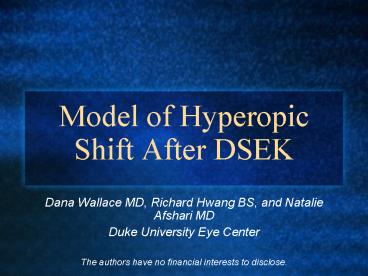Model of Hyperopic Shift After DSEK - PowerPoint PPT Presentation
Title:
Model of Hyperopic Shift After DSEK
Description:
Model of Hyperopic Shift After DSEK Dana Wallace MD, Richard Hwang BS, and Natalie Afshari MD Duke University Eye Center The authors have no financial interests to ... – PowerPoint PPT presentation
Number of Views:41
Avg rating:3.0/5.0
Title: Model of Hyperopic Shift After DSEK
1
Model of Hyperopic Shift After DSEK
- Dana Wallace MD, Richard Hwang BS, and Natalie
Afshari MD - Duke University Eye Center
- The authors have no financial interests to
disclose.
2
DSEK A refractive neutral procedure?
- Partial posterior lamellar transplant indicated
in patients with endothelial dysfunction - Sutureless
- No astigmatic effect
- Now known to induce a hyperopic shift
- Implications on triple procedures (CE/IOL/DSEK)
Covert DJ and Koenig SB. Ophthalmology 2007
1141272-1277. Koenig SB and Covert DJ.
Ophthalmology 2007114221-226. Jun et al. Cornea
2009 28 19-23.
3
Purpose
- Changes in posterior curvature are responsible
for the hyperopic shift that occurs in DSEK. - The magnitude of this shift remains
unpredictable. - To derive a mathematical model that can be used
preoperatively to predict the observed hyperopic
shift after DSEK.
Gorovoy MS. Cornea 2006 25886-889. Koenig SB,
et al. Cornea 2007 26 670-674. Price FW Jr,
Price MO. J Refract Surg 2005 21339-345.
4
Methods
- Based on the assumptions of the thick lens
equation and the Gullstrand model eye, we
developed a mathematical model to predict the
hyperopic shift that occurs after DSEK based on
preoperative pachymetry and endothelial graft
thickness.
5
Formula
- Dcornea Dant Dpost - (d/n)(Dant)(Dpost)
- Dant refractive power of anterior surface
- (1/r1)(nant-nair)
- r1 radius of curvature of anterior surface
- Dpost refractive power of posterior surface
- (1/r2)(nant-naq)
- r2 radius of curvature of posterior surface
- d corneal thickness
- n refractive index
6
As applied to DSEK
- Preoperative corneal power
- Determined by preoperative pachymetry
- Postoperative corneal power
- Graft thickness of the graft was added to the
corneal pachymetry - Graft thickness of the graft was subtracted from
the posterior radius of curvature - The difference in these calculations reveals a
hyperopic shift.
7
As applied to patients
Patient Preop Mrx Preop Pachymetry (µm) Graft Thickness (µm) Predicted Hyperopic Shift Observed Hyperopic Shift
1 0.00-0.50x092 643 103 0.07 1.25
2 0.25-1.25x105 640 100 0.06 0.96
3 0.00-0.25x165 640 142 0.09 0.375
Calculations were only performed in pseudophakic
eyes.
8
Interestingly, if we use the eye as only one
refractive surface, the model is more accurate.
Dcornea (naq-nair)/radius of curvature
Patient Preop Mrx Preop Pachymetry (µm) Graft Thickness (µm) Predicted Hyperopic Shift Observed Hyperopic Shift
1 0.00-0.50x092 643 103 0.58 1.25
2 0.25-1.25x105 640 100 0.56 0.96
3 0.00-0.25x165 640 142 0.80 0.375
9
Other Factors to Consider
- Endothelial graft is thicker peripherally than
centrally - In the first few postoperative months, the graft
edges thin faster than the vertex
10
A more accurate r2
- Can current imaging modalities facilitate these
measurements? - Pentacam
- Anterior Segment OCT
- Can we use a model of an ellipse to more
accurately predict r2?
11
Conclusions
- The hyperopic shift induced by DSEK is the result
of changes in corneal thickness and posterior
radius of curvature - Prediction of the hyperopic shift induced by DSEK
is critical in the planning of refractive
outcomes - Advances in anterior segment imaging will aid in
more accurate prediction of refractive outcomes































